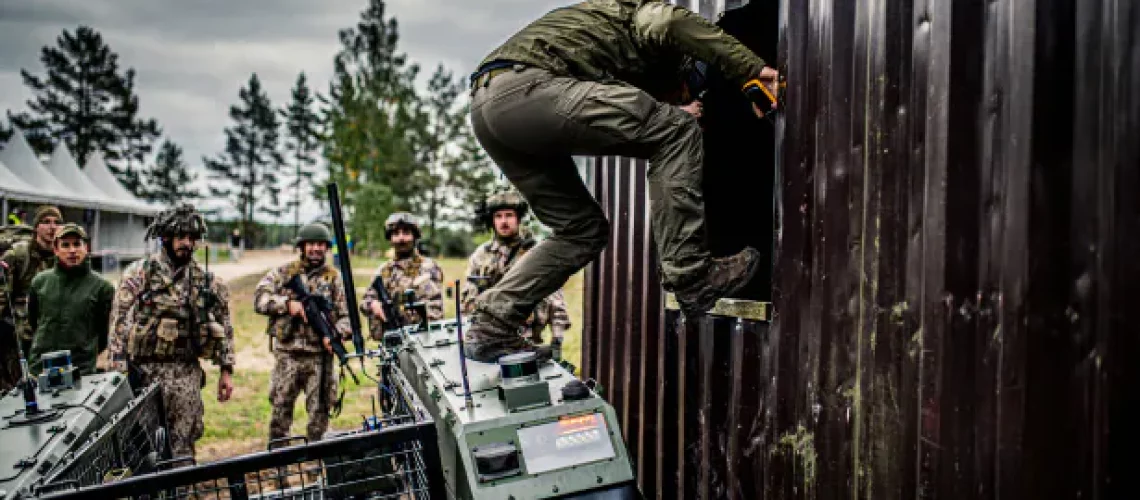While the US Army actively pursues the development of its next-generation robotic capabilities, with the ambitious goal of deploying the first Human Machine Integrated Formations (HMIF) by 2027, projects are multiplying around the world to continue modernizing a capability that is gradually becoming essential on the battlefield.
In France, the 2024-2030 Military Programming Law has allocated 5 billion euros to drones and robots, with the goal for 2030 being the delivery of versatile ground combat platforms. In fact, on December 30, 2024, the “Direction générale de l’armement” (DGA) notified the industrial companies KNDS France and Safran Electronics & Defense of a framework agreement in the field of ground robotics under the name DROIDE: “in support of dismounted combat, the ground robot will increase the capabilities of the combat group while limiting the exposure of soldiers,” stated the Ministry of Armed Forces website last February on this subject.
iMUGS2, symbol of an increasingly operational European architecture
The field of military robotics is generally experiencing significant acceleration in Europe with various initiatives, the most ambitious being the one led by the iMUGS2 consortium – which actually includes the two French industrial companies.
Launched in 2019, the iMUGS project (Integrated Modular Unmanned Ground System) represents one of the European Union’s most important initiatives in the field of military robotics. With a total budget of 32.6 million euros, including 30.6 million granted by the European Commission through the European Defence Industrial Development Program (EDIDP), this project officially responds to the designation “EDIDP-MUGS-2019 Multipurpose architecture for unmanned ground systems and solutions for systems integration and manned-unmanned teaming.”
Seeking to develop a standardized unmanned ground system at the European level, iMUGS aimed to develop a modular, cyber-secure, and scalable architecture for hybrid manned and unmanned systems, targeting the standardization of an ecosystem of air and ground platforms, command, control and communication equipment, sensors, and algorithms.
Coordinated by Estonia and bringing together several European countries – including France, Belgium, Spain, Latvia, Germany, and Finland – iMUGS has proven successful resulting from initial cooperation between fourteen partners: Milrem Robotics (the project coordinator wich provided the THeMIS ground robot as the base), the aforementioned Safran and KNDS, as well as GT Cyber Technologies, Krauss-Maffei Wegmann, Diehl Defence, Bittium Wireless, Insta DefSec, (Un)Manned, dotOcean, Latvijas Mobilais Telefons, GMV Aerospace and Defence, the Estonian Military Academy, and the Royal Military School of Belgium.
Coordonné par l’Estonie et regroupant plusieurs pays européens – dont la France, la Belgique, l’Espagne, la Lettonie, l’Allemagne et la Finlande -, iMUGS a fait ses preuves résultant de la coopération initiale entre quatorze partenaires : Milrem Robotics (le coordinateur du projet dont le socle est le robot terrestre THeMIS), Safran et KNDS déjà mentionnés, mais aussi GT Cyber Technologies, Krauss-Maffei Wegmann, Diehl Defence, Bittium Wireless, Insta DefSec, (Un)Manned, dotOcean, Latvijas Mobilais Telefons, GMV Aerospace and Defence, l’Académie militaire estonienne et l’École royale militaire de Belgique.
Following the success of the first iMUGS project completed at the end of 2023, the consortium has expanded considerably with twenty-nine partners from fifteen EU countries and continued its work with iMUGS2 based on an official proposal submitted in November 2024 in response to the European Defence Fund (EDF) call designated EDF-2024-DA-GROUND-UGS-STEP.
The objective of iMUGS2 is also ambitious: to develop an unmanned ground system capable of collaborating both with autonomous robotic platforms (“unmanned-unmanned teaming”) and with human-piloted infantry vehicles (“manned-unmanned teaming”).
Le but est de développer des technologies qui seront déployables d’ici 2030, faisant ainsi la transition des systèmes expérimentaux vers des solutions complètement opérationnelles.
The goal is to develop technologies that will be deployable by 2030, thus transitioning from experimental systems to fully operational solutions.
The obstacles to overcome remain, for both the United States and Europeans, the degree of autonomy of the robots, managing the cognitive saturation of the end-users, and controlling these capabilities that are meant to be “in the first line of contact” and therefore likely to be captured by the enemy.
(By Murielle Delaporte)
Photo © Milrem Robotics (https://milremrobotics.com/eu-projects/imugs2/)
